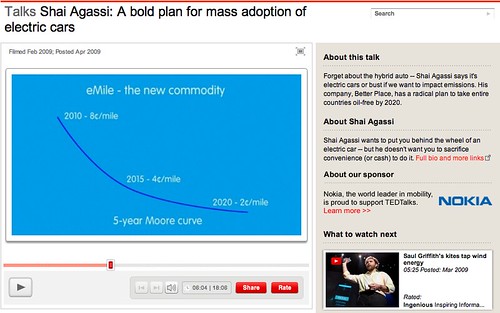
I have been a fan of Better Place and their unique model around electric vehicles since I watched Shai Agassi’s presentation at the DLD conference in January 2008.
If you are unfamiliar with the Better Place model, they looked at the idea of electric vehicles and people’s ‘range anxiety’ and asked how best to solve it. Their plan, put charging stations anywhere people park and build cars (or have a partner build cars) with readily swappable batteries, so if you are traveling beyond the range of the battery in your car, you drop into a swap station when your battery starts to be depleted, swap batteries and drive on. Simple!
In the Better Place business model, Better Place owns the battery in your car and charges you for the energy your battery uses – similar to how a mobile phone company charges you for minutes talktime.
Being a fan of the Better Place model I watched Shai’s talk at the TED conference earlier this year with great interest and he didn’t disappoint. A very inspirational talk. Until you start to do the maths!
Shai mentioned a price of 8c per mile (in the US) for driving a Better Place car. Frankly this sounds expensive to me.
I filled the tank in my car yesterday and took a note of the price. It was €0.948 per litre. Now my maths are not the best so bear with me while I work through this (and please do point out any errors in the comments – I want to be proven wrong on this!).
I use 5.1 litres per 100 km in my car so to drive 100km costs me €4.8348 (5.1 x €0.948).
This is €0.048 per km (€4.83/100).
This is €0.077 per mile (€0.048/.625).
This is US$0.10 per mile at today’s currency conversion rate.
If my current miles are costing me US$0.10 per mile and Shai is offering miles at US$0.08 it is not a hugely compelling case he’s making!
Now in fairness to Shai, I drive a 2008 Prius and the 5.1L/100km is roughly equal to 46mpg (using US gallons) which is about as good as you are going to get (esp as that figure is an average of urban and long-distance driving, not the maximum achieved on long-distance).
Still, for me, Shai’s 2015 figure of US$0.04 per mile is far more compelling than the 2010 US$0.08.
How much do you spend per mile and is US$0.08 attractive to you?
Related articles by Zemanta
- Electric cars are cheaper and faster than any hybrid on the market (funtoosurf.com)
- Shai Agassi: eMile’s and Electric Cars (whiteafrican.com)
- The Green Issue: Batteries Not Included (nytimes.com)
- Better Place Electric Cars (neublack.com)
- Ontario to roll out Better Place car charging infrastructure (greenmonk.net)


